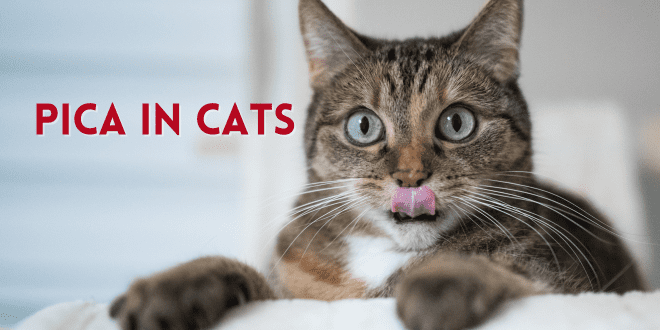
Pica is the term used for the behavior of eating or sucking non-food material. The most common material associated with pica is usually wool such as blankets, socks, shirts, or jackets. Pica is also sometimes referred to as wool eating. Some cats will nibble on just about anything though, such as paper, plastic, litter, or shoelaces. Pica behavior is of concern because it can lead to serious health problems if the material ingested causes problems in the digestive tract, most especially an obstruction. Surgery is needed to remove obstructions due to pica.
What Causes Pica in Cats?
Pica is considered an obsessive/compulsive-type behavior. There are many possible reasons for pica behavior such as:
Deficiencies in the diet. Nutritional deficiencies in the diet may lead a cat to crave these nutrients from non-edible sources. Some cats who are anemic may try to eat litter.
Stress. Cats who are living in a stressful environment may try to self-soothe by engaging in pica behavior. Changes in the environment such as a move to a new home, or the addition of absence of a family member can be stress triggers that can lead to pica.
Boredom or Lack of Attention. A bored cat who is not receiving adequate mental and physical stimulation might begin munching on non-food items just for something to do.
Underlying medical problems. Certain diseases such as diabetes, dental disease, hyperthyroidism, or brain disorders may be associated with pica behavior. Chewing may relieve some discomfort.
Genetics. Some breeds can be genetically predisposed to the behavior. Pica seems to be more common in Oriental breeds such as Siamese and Burmese.
Abrupt weaning. Some kittens who were weaned too early or abruptly may engage in this behavior.
Displacement. Whether the cause is boredom, stress, or frustration, a cat may turn to pica (as well as other behaviors) as a displacement behavior. It can also be a displacement behavior when the cat would rather be doing something else but is unable to or if the cat has been punished.
Some Signs to Look For
- Constipation or straining
- Vomiting
- Diarrhea
- Evidence of non-food items in feces
- Lethargic behavior
- Lack of appetite
- Lack thirst
- Increased vocalization
The above signs could also indicate any number of potential medical issues. What’s most important is that if you notice any change in your cat’s behavior, litter box habits, appetite, water consumption, vocalization, or physical appearance, then an examination by the veterinarian is needed.
Treating Pica
Veterinary exam. Have your cat examined by the veterinarian. If there is an underlying medical problem it will need to be diagnosed and addressed.
Dietary adjustments. Your veterinarian may make a recommendation for supplementing your cat’s food or a therapeutic food formula may be prescribed. Don’t make any dietary adjustments without consulting with your veterinarian. An inappropriate amount of fiber added to the diet can cause major intestinal distress.
Remove temptation. If kitty is munching on socks or items that shouldn’t be accessible, make sure temptation is removed by keeping clothing in drawers, closets, or in hampers with lids. If your cat is chewing on plants, remove them from the indoor environment. Do your best to keep items of temptation out of your cat’s reach. Don’t punish the cat for chewing on items as that will simply increase frustration and stress. If you see your cat chewing on a non-food item, use redirection.
Provide mental and physical stimulation. A bored cat will look for something to do and that something might include chewing on a non-edible item. Increase environmental enrichment by providing puzzle feeders, activity toys, scratching posts, cat trees, and other forms on stimulation. Place a cat tree near a window so your cat can watch the outdoor activities. If you think your cat would enjoy some exposure to outdoors, consider purchasing or constructing a safe outdoor enclosure, commonly referred to as a catio. Some of them are just enclosures that can be installed in windows and others are more elaborate and have walkways for kitty.
Interactive play therapy. Engage your cat in a couple of interactive play therapy sessions per day. When you use a fishing pole-type toy you can control the movements so your cat is able to truly benefit both mentally and physically. Your cat gets to be the “mighty hunter” and enjoy stalking, pouncing and capturing. Be consistent about the play schedule and try to conduct at least two 15-minute sessions per day. Cats like the comfort of familiar routines.
Safe alternatives for chewing. In addition to puzzle feeder toys, try growing some safe kitty greens (rye, oat or wheat grass) or catnip for your cat. You can find kitty greens kits in your local pet product store and online. You can also buy an already-grown square of grass from many organic food stores or grow your own. Don’t offer grass from your lawn because it’s often treated with chemicals and fertilizers.
Reduce stress. Use your detective skills to identify stressors in your cat’s environment. Is there another companion cat causing tension? Is there stress in the family? Have you made changes to your cat’s environment? Stress triggers can be big and obvious or they can be small and easy for humans to overlook. Work on creating a more secure and comforting environment for your cat. Make sure kitty has cozy little hideaways for napping, elevated areas to look over the environment, has a secure feeding station location and a secure litter box area. Look at the environment from your cat’s point of view. In a multicat household, be sure there are adequate resources for each cat and that they’re located in various areas so one cat doesn’t have to cross another cat’s preferred area in order to access the litter box, food/water bowls or a napping location.
Get professional help. Your veterinarian may recommend a referral to a veterinary behaviorist or certified cat behavior consultant so a comprehensive behavior treatment plan can be established.
Need More Information?
For more information on cat behavior and training, refer to the best-selling books by Pam Johnson-Bennett. Her books are available at bookstores and online. We’ve included links to Amazon here on our website.
If you have a question regarding your cat’s behavior or health, please contact your veterinarian. This article is not intended as a replacement for your cat’s veterinary care. This article is for information purposes only and not offering medical advice or providing a medical diagnosis.





